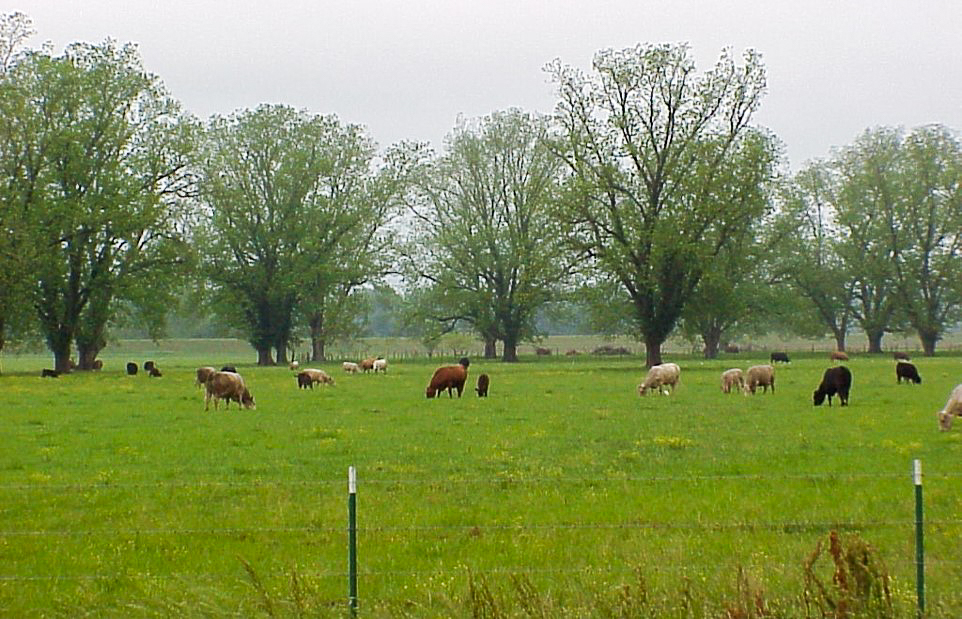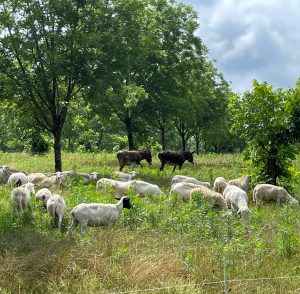Proper Integration of Livestock can be Beneficial to Soil Health

Cattle grazing in a pecan orchard. (Photo by Charles Rohla)
Why is the integration of grazing livestock important for soil health?
Livestock can play an integral role in improving the Four Ecosystem Processes important for healthy soils. With proper grazing, the forage plants can recover to near maturity, resulting in more solar energy captured from the sun. This solar energy converts to carbohydrates that produce the biomass in the plants and feed the microorganisms in the soil by releasing exudates from the root system into the surrounding soil. The action of grazing causes the plant to release more exudates into the ground, boosting the population of microorganisms. This release kickstarts the soil web, increasing nutrient cycling and making nutrients more available to the plants.

More and more ranchers are running sheep and goats, which may be better choices to graze in the orchards. (Photo by Charles Rohla)
Over 90% of the nutrients consumed by the livestock are recycled back to the soil in the dung and urine. If the livestock is a ruminant (cattle, sheep, goat, deer, or buffalo), additional microbes from the rumen will be released in the dung. The microbes in the rumen are similar to the microbes in the soil; therefore, the manure will prime the soil with biological life, contributing to healthier soils. As the livestock graze, their hoofs break up any crusting on the soil surface. This hoof action will help increase water infiltration into the ground and reduce runoff during rain or irrigation events. As livestock trample and lay down, they will press any present seeds into the soil, resulting in better emergence of new seedlings and increasing diverse forage biomass. If you have a lot of residue on the ground, this trampling will also help incorporate this carbon source into the environment, allowing the soil microbes to consume it. Incorporating carbon will increase the organic matter in the soil and help increase nutrients available to the growing plants.
The proper way to graze for soil health
Grazing for soil health is more than just having livestock grazing. Management of the grazing events is critical to get the full benefits of the livestock and improve soil health. We do not want to remove all the grass down to 2 inches as we would if we were mowing. We want livestock to take a bite from each plant in the pasture and move on (grazing efficiency). Efficiently grazing allows the plant to release more exudates into the soil and continue to capture as much solar energy as possible to feed the soil microorganisms.
Before the plant regrows, the animals should be moved to the next pasture (typically two to five days). Rotationally grazing around this time frame will do two important things: first, the grasses will recover quicker and produce more total forage; second, the animals will consume the highest quality forage available, increasing their gains (profits). Animals should not return to a grazed pasture until the plants have had time to recover from the last grazing event. Using smaller pastures/paddocks will help increase grazing efficiency, forcing animals to consume less desired plants and increase the hoof impact on the soil. The concern for compaction is reduced when grazing is effectively managed. In fact, with proper grazing management, soil structure improves, and the effects of compaction diminish.
Benefits of integrating livestock into the orchards
There are several benefits to adequately managing livestock in orchards to increase soil health. Just a few of these benefits are:
- Increases water infiltration
- Grows more forage, allowing a producer to return to the orchard quicker after a rain event
- Animal manure can increase organic material in soil
- Animal manure feeds microorganisms in the ground and can attract other beneficial organisms to the orchard
- Promotes species diversity
- Helps with weed control
- Increases nutrient cycling in the soil
- Spreads financial risk over different enterprises
- Reduces labor and cost for mowing
- Increases soil carbon and nitrogen in the soil
- Allows diverse plants to mature and thus helps mine other nutrients from the soil (Phosphorus, potassium, zinc, etc.)
To capitalize on these benefits does not mean that you have to have animals in the orchard year-round. Ideally, the length and timing of a grazing event or events would depend on your operation and when forage is available for the livestock. To increase soil health, at least one grazing event yearly would significantly increase the ecosystem processes, resulting in healthier soils and all the benefits of healthier soils.
The other thing to remember is that you do not have to own the livestock as a pecan grower. Numerous livestock producers in the Pecan Belt are looking for additional land to graze. You can always work with a local livestock producer to graze your orchards and even generate revenue from the grazing. The livestock producer could be responsible for all the livestock management and associated costs. If you work with someone else to bring the livestock in, be sure that they understand your goals for the grazing and that they are willing to graze the livestock to improve the soil health properly. Otherwise, the grazing could negatively impact your soils. Typically, we think about grazing with cattle, but more and more ranchers are running sheep and goats, which may be better choices to graze in the orchards.
I recommend considering the use of livestock grazing in your orchard to improve your soil health. Utilizing livestock grazing will significantly impact soil health and inevitably strengthen the overall health of your orchard.

